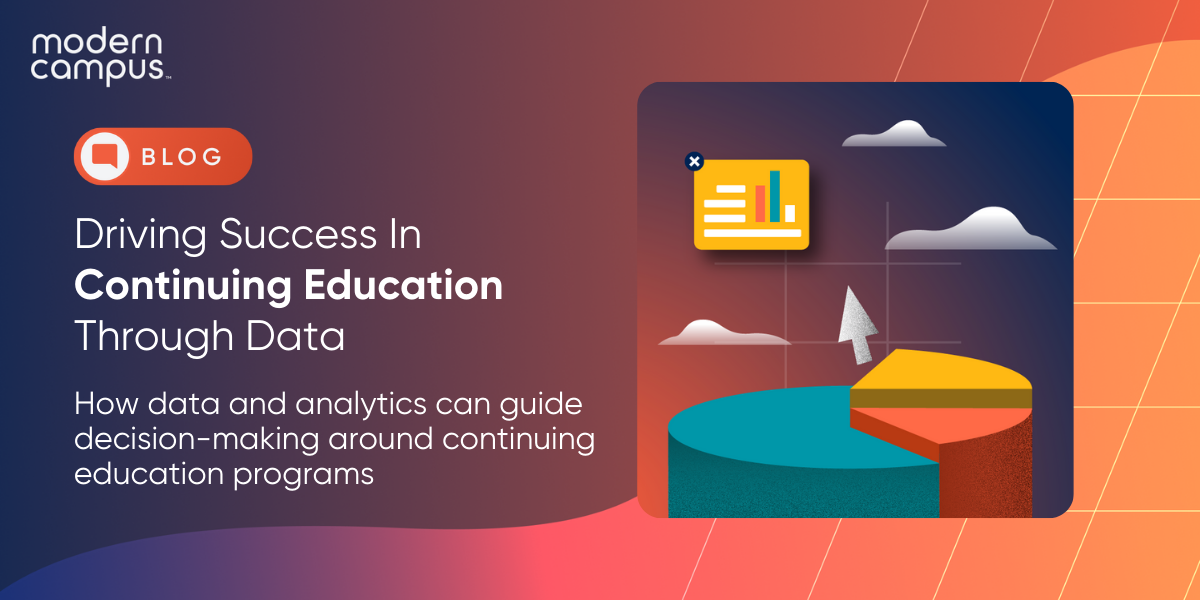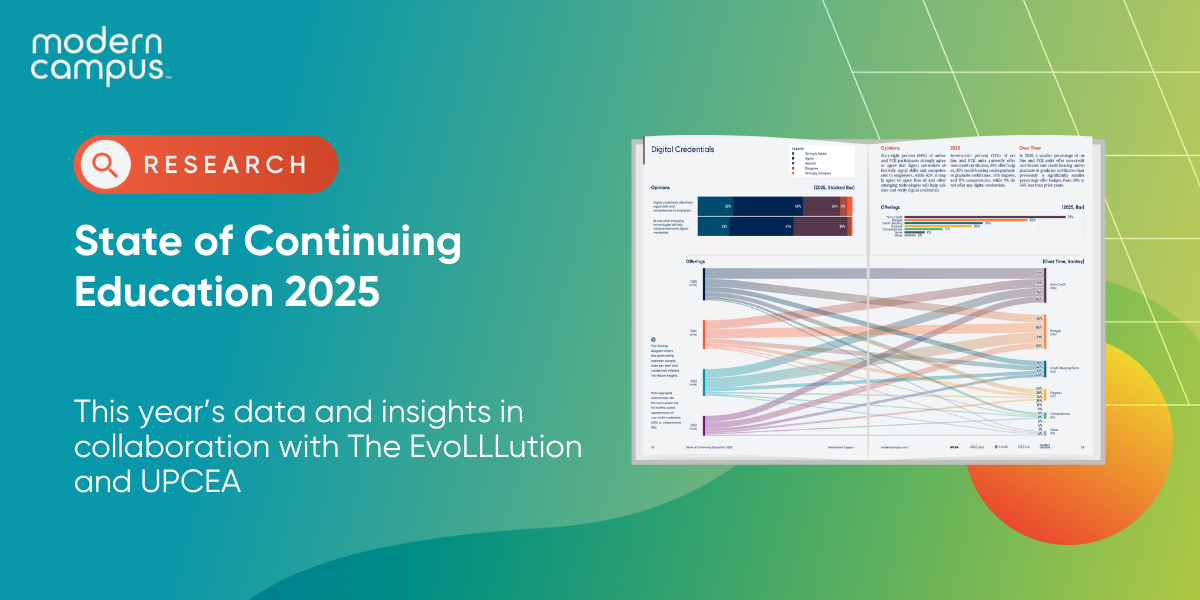Driving Success in Continuing Education Through Data
Not everyone’s a data scientist. Given a document brimming with numbers, even the most agile leaders struggle to make sense of the figures; opting instead to pass them on to “the number people”.
Twenty years ago, this would’ve been perfectly reasonable. But just as there’s no excuse for puzzling over the capital of Uruguay when Google is a tap away, there’s no longer any reason for division leaders to be ignorant of data that can be close at hand.
Why is Data Important for Continuing Education?
Data-based decision-making is at the heart of any successful business, whether it’s a corner store or an institution of higher education. Unfortunately for Continuing Education divisions, this information is frequently out of reach or incomprehensible to the people who need it most. According to a recent report, more than half of CE leaders cannot easily access enrollment numbers for their online and professional continuing education units.
Main campus systems aren’t built to collect clean data for non-traditional divisions, leaving CE leaders flying blind. Especially with non-traditional education taking the stage as “the new normal”, having clear markers for your school’s performance is more important than ever.
Lacking easily readable metrics, non-traditional education leaders are often unaware of the division-growing decisions that have slipped through the cracks. Having access to that data means leaders can easily spot areas requiring attention and call the shots accordingly.
Here are four roadblocks to good decision-making and how leaders can leverage the corresponding data to address them.
Common Errors Made Without Data
1. Not Understanding Students’ Needs
The days of cobbling together a course, opening the doors and watching the seats fill up are gone. Where once a student’s choice of program hinged largely on its affordability and their proximity to the campus, today’s learners are choosing from a much wider plate of options to accommodate an increasingly specialized workforce.
Non-traditional divisions need to cater to these preferences if school-based learning is expected to keep up with the legions of free educational resources online. Having historical data for all past programs and courses at the ready ensures resources are being allocated properly, and classes offered at the right times.
With digestible data on hand, you may find that you’re over-offering courses—holding a course every single term when it’s only popular in one. With that insight, you’d know to move that course to just one term and would have more students applying to that time slot.
Understanding course demand also means no more eight-person classes in 30-seat rooms. Program administrators know to offer such a class only when it’s most popular, saving bigger spaces for bigger turnouts. Consolidation is the name of the game; No need for three sections if there are fewer students in the room than dry-erase markers.
2. Sending a Human to Do a Computer’s Job
The argument against leaving certain tasks to machines makes less sense every day—and with every missed payment or enrollment mishap, it weakens.
Staff are people, and people make mistakes. In the case of expensive investments like higher education, those mistakes can be the difference between a long-term student and a lost prospect.
Computers produce the same result every time with the right automation. It reduces the chance of human error and gives efficiency a boost by allowing staff to focus their efforts on critical work. You can set an automation to pay instructors as soon as their students have been graded; notify students any time a full program gains a free seat and another to let them know when a course matching their interests has just opened.
Give in to the machines and give your staff a break.
3. Making Uninformed Decisions
It’s nice to look out of your windshield as you drive. Seeing precisely where you are, where you’re heading and what obstacles surround you is the only way to make appropriate decisions.
Most campus management systems are built to support credit-bearing programming, meaning they rely on cohorts and semesters to track student progress. For non-traditional education, it’s rare for institutions to report on their numbers with confidence.
Real-time reporting tools reveal what’s happening live. Enrollment trends, top financial performers, student purchase histories and trends, facility use, student address mapping, and finance tracking —these are key to knowing where to place your attention if growth is your aim. Instant analytics let you understand the performance of your programs, laying the groundwork to decide which programs to continue offering and which may no longer be relevant to learners.
4. Not Making Information Digestible
While figures alone are useful to staff who don’t mind sifting through raw statistics, it’s better to have them compiled in a visual format that anyone can understand. Not only does it take the legwork out of finding out how many students are enrolled in any given course, but it makes it easy to appeal to senior leadership when it’s decision time. Executives don’t often have time to spool through the details, so having clear visual indicators gives any decision another leg to stand on.
To a division leader, a spreadsheet full of numbers says, “Compare these numbers to the other numbers”. Conversely, a bar graph showing your top ten courses for enrollment says, “The numbers have been compared. Have a coffee and make your decision.”
This ease of reference makes getting up to speed a breeze. A couple clicks in, a marketing strategist can run the reports on enrollment transactions in the past 24 hours and know when to bump up the school’s promotional efforts.
There’s also a lot to learn about who is involved. Students often provide auxiliary information about themselves that, in a Google-esque fashion, can be leveraged to provide insights into their preferences and behaviors.
Employers, communication preferences, goals, interests – when you know a student works in HR, responds best to emails and is looking to buff up their soft skills, it makes that afternoon email about your new Conflict Resolution certificate land more smoothly.
Good Data Means Good Decisions
Business analysts no longer bear sole responsibility for understanding your institution’s metrics. It falls on administrators to know which way the wind is blowing as well.
The capacity to maintain and grow enrollment numbers relies on the ability to evaluate and leverage data at hand. Prospects have limitless choices before them, and administrators need constant visibility of all aspects of their division’s performance if they want their institution to stand out.
Want to see how your continuing education unit compares to others?
Each year, in partnership with UPCEA, The EvoLLLution and CAUCE, Modern Campus publishes the State of Continuing Education report to help CE leaders, professionals and partners understand the trends, challenges and triumphs of the field. Download the 2025 report for insight into how data, when available, is helping leaders make informed decisions and driving industry-changing improvements.
Last updated: June 10, 2025





